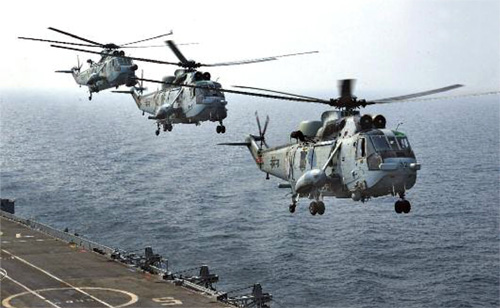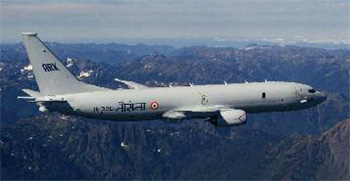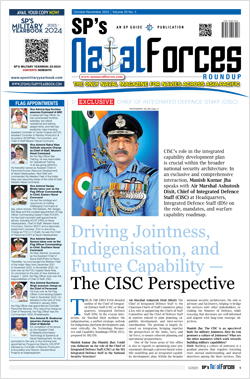INDIAN ARMED FORCES CHIEFS ON OUR RELENTLESS AND FOCUSED PUBLISHING EFFORTS

The insightful articles, inspiring narrations and analytical perspectives presented by the Editorial Team, establish an alluring connect with the reader. My compliments and best wishes to SP Guide Publications.

"Over the past 60 years, the growth of SP Guide Publications has mirrored the rising stature of Indian Navy. Its well-researched and informative magazines on Defence and Aerospace sector have served to shape an educated opinion of our military personnel, policy makers and the public alike. I wish SP's Publication team continued success, fair winds and following seas in all future endeavour!"

Since, its inception in 1964, SP Guide Publications has consistently demonstrated commitment to high-quality journalism in the aerospace and defence sectors, earning a well-deserved reputation as Asia's largest media house in this domain. I wish SP Guide Publications continued success in its pursuit of excellence.
- Global Partners Urged to Tap India's Shipbuilding Potential: Rajnath Singh at Samudra Utkarsh
- All about HAMMER Smart Precision Guided Weapon in India — “BEL-Safran Collaboration”
- India, Germany deepen defence ties as High Defence Committee charts ambitious plan
- G20 Summit: A Sign of Global Fracture
- True strategic autonomy will come only when our code is as indigenous as our hardware: Rajnath Singh
- India–Israel Joint Working Group Meeting on defence cooperation to boost technology sharing and co-development
Cover Story
Indian Navy’s Charted Course
Barring the serious setbacks in submarine build-up plan with severe implications on its dwindling force level, the Indian Navy’s acquisition and modernisation plans are well on track, despite some prestigious projects missing the delivery milestones

The Indian Navy’s Maritime Military Strategy has adopted a generic capability building approach, which is founded on the premise: “The Indian Navy is today a potent and capable force which is highly regarded for its professional competence. The planned induction of advanced platforms and technology, and creation of modern infrastructure, promises to boost the capabilities of the service even further in the near future.” Indian Navy’s Maritime Military Doctrine therefore propounds the basic philosophy to develop capabilities that would enable it to influence events ashore and to undertake ‘military manoeuvre from the sea’. The Navy’s Maritime Capability Perspective Plan (MCPP) was drawn out for force development and modernisation, spanning over next three plan periods, 2005-2022, and aims to equip the Indian Navy with the capability to meet contemporary and future challenges.

Surface Fleet
Aircraft Carrier Programme: Indian Navy’s sole carrier Viraat is kept operational through periodic cycles of extensive refits to provide life extension. The latest extensive refit included refurbishment, strengthening of the hull wherever necessary, major overhaul of its propulsion system, comprising twin steam turbines, re-tubing of her boilers, etc.
The acquisition of extensively refitted and modernised former Russian ICBM carrier Admiral Gorshkov, now rechristened as Vikramaditya, at a final cost of $2.35 billion, has reached the final phase with commencement of its sea trials. The crew to man Vikramaditya is expected to reach Severodvinsk in April for operational training and acceptance trials. According to the Defence Minister A.K. Antony, Vikramaditya is expected to be inducted into the Indian Navy by the first quarter of 2013 post sea acceptance trials.

Indigenous construction of prestigious 37,500 tonnes indigenous aircraft carrier (IAC) is reportedly on track with the likely commissioning of the ship by 2014. The IAC would embark an Air Wing with a mix of up to 30 aircraft consisting of MiG-29Ks and the indigenous LCA (Navy) Tejas, as also rotary wing assets to include KA 31 AEW helicopters. Fixed wing aircraft operations would be based on short take-off but arrested recovery (STOBAR). The carrier will be powered by four HAL-built General Electric LM 2500 gas turbines driving two shafts that would give the ship a top speed of over 28 knots.
Follow-on programme of two additional IAC of 45,000 tonnes has the approval of the government. Yard nomination for this project, however, seems to be in doldrums as the Cochin Shipyard Ltd has limited space and infrastructure to undertake construction of aircraft carriers of higher tonnage and overall dimensions. Thorny issue, however, is the finalisation of design for IAC II and III.
In January this year, LCA (Navy) Tejas, has missed another window for its first flight. Reportedly this has attracted first explicit criticism from Indian Navy. Apparently, the Aeronautical Development Agency (ADA) having accorded priority to the Air Force variant of the Tejas, its naval variant has fallen way behind the schedule projected by the Indian Navy for induction. After the first prototype was ceremonially rolled out in July 2010, the aircraft has suffered weight issues and problems with its landing and certain control laws, including sink rate parameters. There are serious misgivings that the indigenous LCA Navy Mk.1 may never actually land on an aircraft carrier, as reportedly the aircraft is too underpowered for safe carrier operations. Therefore, India’s first home-built carrier-borne fighter jet may actually be the LCA Navy Mk.2, powered by a GE F414 turbofan, which meets the thrust requirements prescribed by the Indian Navy.
After losing out to GE in the race to power the LCA Tejas Mk.2, there are speculations rife that the Eurojet’s concept naval Typhoon, may be in contention as a fighter for the Indian Navy’s future IAC. However, there are indications that IAC II and III designs are likely to incorporate catapult mechanisms to launch aircraft, while the naval Typhoon is conceptualised as a ski-jump launched fighter. In this eventuality, Dassault offers much brighter prospects if Rafael M with shorter version of the catapult system, 75m, USN Type C 13-3, steam catapult is offered. Induction of Rafale into the Indian Air Force (IAF) under the medium multi-role combat aircraft (MMRCA) programme should provide naval ship designers food for thought, as they grapple with design finalisation for future carriers.
Project 17: The first two ships of the Project 17 stealth frigates built by Mazagon Dock Limited (MDL) have been commissioned with the last ship Sahyadri scheduled to join the fleet by end 2012. The ship’s stealth capability is provided through the incorporation of systems to minimise its signatures. These include an infrared suppression system (IRSS) provided by Canada’s Davis Engineering; acoustic and vibration signatures would be suppressed by use of noise and vibration-proof mounts and the design caters for reduced radar cross section. These ships are capable of carrying two advanced multi-role helicopters. These new stealthy powerful platforms will add significant punch to the Navy’s sword arm.
Projects 15A & 15B: The three follow-on Delhi class destroyers form Project 15A and are designated as the Kolkata class, with second and third ships to be named as Kochi and Bangalore. These ships are considerably different from their predecessors with the incorporation of stealth features and advanced technology. The major changes will include the fitment of up to 16 vertically launched BrahMos missiles and the new long-range Barak NG, LR-SAM being jointly developed by the Defence Research and Development Organisation (DRDO) with Israel’s IAI, as also new sensors. Additional four ships of the same class to be designated as Project 15B have been approved to be built by MDL and the Garden Reach Shipbuilders and Engineers (GRSE). Although the design is the same these are likely to have enhanced weapons and systems such as BrahMos II and the extended range Barak (ER-SAM).
Stealth Frigates: The construction of three follow-on Talwar class GM stealth frigates from Russia is under way with delivery of first ship in 2013 and the other two within the next 12 months. These are to be named as Tej (sword), Tarkash (Quiver) and Trikand (Tri-Pronged). The major change in the new series of stealth frigates is replacement of the Klub missiles with the BrahMos system.
Stealth ASW Corvettes: Four new stealth ASW platforms under Project 28, based on the Kora Class corvette design are being built by GRSE, Kolkata, and are now expected to join the fleet by the middle of 2012 onwards. At 2,500 tonnes and designed for a minimised signature profile to provide stealth capability, these ships would considerably augment the Navy’s ASW capability.
Amphibious Capability: With the induction of the landing platform dock (LPD) Jalashwa, the Indian Navy has considerably augmented its amphibious capability. Together with the five landing ship tanks (large), a sealift capability for over 3,500 troops and a squadron of armour now exists. To augment its amphibious lift capability, Indian Navy has planned to build larger amphibious ships of the LPD variety. This project may be pursued through external design collaboration on the model for the IAC Project. Discussions are said to be on with various prospective shipbuilders for selection of suitable design requirements. RFP for air cushion vehicles for transfer of troops ashore has reportedly been issued by the government.





